
- Events
- Australia Day
- Bastille Day
- Burns Night
- Christmas
- Darts
- Day of the Dead
- Eurovision
- Festivals / Summer
- Halloween
- Halloween Accessories
- Nativity
- Oktoberfest
- Olympics
- Pride
- Red Nose Day
- School Play Costumes
- St Andrew's Day
- St Davids Day
- St Georges / England Supporters
- St Patricks Day
- Six Nations Rugby
- Stag Do
- Summer
- Thanksgiving
- VE Day
- World Book Day
- Adult World Book Day Costumes
- 4th July

- Themes
- Animals
- Around The World
- Book Characters
- British
- Chocolate Factory
- Cops & Robbers
- Cosplay
- DC
- Doctors and Nurses
- Fairytale
- Funny / Novelty
- Gangster
- Harry Potter
- Hawaiian / Summer
- Heroes and Villains
- Historical
- Army, Air Force & Naval
- Mexican Fiesta
- Pick Me Up
- Pink Cowgirl Hat Aesthetic
- Pirates
- Popstars and Celebrities
- Pre Historic
- Religious
- Sexy Costumes
- Sports
- Star Wars
- Steampunk
- Suits
- Tiger King
- TV, Film and Game
- Wild West
- Wizard of Oz
- Wizards & Witches
- 2000s
- 1990s
- 1980s
- 1960s 1970s
- 1950s
- 1940s
- 1920s

- Cosmetics
- Body Crayons
- Eye Liner
- Fabric Paint
- Face & Body Paint
- Face Jewels
- Fake Blood
- FX Fluids
- Glitter Fixatives
- Glitter Gel
- Glitter Shaker
- Hair Colour Spray
- Hair Gel
- Hair Streaks
- Lipgloss
- Lipstick
- Lip Tattoos
- Loose Glitter
- Mascara
- Nail Polish
- Pigment Shakers
- Pro Face Paint Cake Pots
- Scars, Wounds, Prosthetics & FX

- Accessories
- Bandanas & Scarves
- Belts
- Braces
- Capes
- Elf Accessories
- Eye Lashes
- Facial Hair
- Feather Boas
- Glasses
- Gloves
- Guns, Weapons & Swords
- Hats & Headwear
- Hosiery
- Inflatables
- Jewellery
- Masks
- Masquerade Masks
- Nipple Pasties
- Pacifiers
- Props
- Sets & Kits
- Shoe Covers
- Shoes / Boots
- Sleeves
- Teeth
- Ties & Bowties
- Tutus & Underskirts
- Wigs
- Wings & Wands
- Other

- Gifts by Category
- Alternative
- Balloon Dog Sculptures
- Batteries
- Colouring Books
- Decorative Accessories
- Food & Drink
- Fragrance
- Gadgets & Tech
- Gift Sets
- Gifts for the Home
- Homeware
- Jewellery
- Keepsakes
- Knitting Wool
- Life
- Luggage & Suitcases
- Miscellaneous
- Ornaments
- Personalised Gifts
- Puzzle Books
- Puzzles
- Slippers
- Smoking
- Stationery
- Umbrellas
- Vehicle
- Wallets & Purses
- Warmies


-
- Australia Day
- Bastille Day
- Burns Night
- Christmas
- Darts
- Day of the Dead
- Eurovision
- Festivals / Summer
- Halloween
- Halloween Accessories
- Nativity
- Oktoberfest
- Olympics
- Pride
- Red Nose Day
- School Play Costumes
- St Andrew's Day
- St Davids Day
- St Georges / England Supporters
- St Patricks Day
- Six Nations Rugby
- Stag Do
- Summer
- Thanksgiving
- VE Day
- World Book Day
- Adult World Book Day Costumes
- 4th July
-
- Animals
- Around The World
- Book Characters
- British
- Chocolate Factory
- Cops & Robbers
- Cosplay
- DC
- Doctors and Nurses
- Fairytale
- Funny / Novelty
- Gangster
- Harry Potter
- Hawaiian / Summer
- Heroes and Villains
- Historical
- Army, Air Force & Naval
- Mexican Fiesta
- Pick Me Up
- Pink Cowgirl Hat Aesthetic
- Pirates
- Popstars and Celebrities
- Pre Historic
- Religious
- Sexy Costumes
- Sports
- Star Wars
- Steampunk
- Suits
- Tiger King
- TV, Film and Game
- Wild West
- Wizard of Oz
- Wizards & Witches
- 2000s
- 1990s
- 1980s
- 1960s 1970s
- 1950s
- 1940s
- 1920s
-
- Body Crayons
- Eye Liner
- Fabric Paint
- Face & Body Paint
- Face Jewels
- Fake Blood
- FX Fluids
- Glitter Fixatives
- Glitter Gel
- Glitter Shaker
- Hair Colour Spray
- Hair Gel
- Hair Streaks
- Lipgloss
- Lipstick
- Lip Tattoos
- Loose Glitter
- Mascara
- Nail Polish
- Pigment Shakers
- Pro Face Paint Cake Pots
- Scars, Wounds, Prosthetics & FX
-
- Bandanas & Scarves
- Belts
- Braces
- Capes
- Elf Accessories
- Eye Lashes
- Facial Hair
- Feather Boas
- Glasses
- Gloves
- Guns, Weapons & Swords
- Hats & Headwear
- Hosiery
- Inflatables
- Jewellery
- Masks
- Masquerade Masks
- Nipple Pasties
- Pacifiers
- Props
- Sets & Kits
- Shoe Covers
- Shoes / Boots
- Sleeves
- Teeth
- Ties & Bowties
- Tutus & Underskirts
- Wigs
- Wings & Wands
- Other







-
- Alternative
- Balloon Dog Sculptures
- Batteries
- Colouring Books
- Decorative Accessories
- Food & Drink
- Fragrance
- Gadgets & Tech
- Gift Sets
- Gifts for the Home
- Homeware
- Jewellery
- Keepsakes
- Knitting Wool
- Life
- Luggage & Suitcases
- Miscellaneous
- Ornaments
- Personalised Gifts
- Puzzle Books
- Puzzles
- Slippers
- Smoking
- Stationery
- Umbrellas
- Vehicle
- Wallets & Purses
- Warmies

What is a Gazebo?
by Darren Butler
Last updated: Jul 08, 2024

In the world of outdoor architecture, few structures evoke the same sense of charm, tranquility, and practicality as a gazebo. Whether nestled in a private garden, standing tall in a public park, or adorning the grounds of a grand estate, gazebos have a universal appeal that transcends cultures and centuries. But what exactly is a gazebo, and what makes it such a beloved addition to any landscape? Let's delve into the fascinating world of gazebos, exploring their origins, evolution, and enduring allure.

Origins and Historical Evolution
The term "gazebo" is believed to have originated in the early 18th century in Britain. It derives from the Latin word "gazebo," meaning "I shall gaze." Historically, gazebos were often built in gardens or parks to provide a shaded retreat where one could relax, enjoy the view, and entertain guests.
Gazebos have a rich history across different cultures. In medieval and Renaissance Europe, they were symbols of wealth and status, often found in the gardens of nobility and royalty. These early gazebos were typically constructed of stone or wood, featuring ornate carvings and intricate designs.
In Asia, similar structures known as pavilions or pagodas served analogous purposes, offering spaces for contemplation, social gatherings, and artistic performances. The design and materials varied according to local traditions and available resources.

Architectural Features and Designs
Gazebos are characterised by their open sides, roof, and freestanding structure, which distinguish them from other garden structures like pergolas or arbors. Their roofs can be domed, octagonal, hexagonal, or rectangular, and they may feature intricate latticework or solid sides depending on the desired level of privacy and protection from the elements.
Traditional materials for constructing gazebos include wood, stone, and metal, each offering its own aesthetic and functional benefits. Wood is favoured for its natural warmth and versatility, while stone provides durability and a classical appearance. Modern gazebos may also incorporate materials like vinyl or composite materials for easier maintenance and longevity.
The design of gazebos has evolved over time to accommodate various purposes and architectural styles. From Victorian-era ornate gazebos adorned with gingerbread trim to minimalist contemporary designs emphasising clean lines and simplicity, gazebos can complement any landscape or architectural theme.

Practical Uses and Cultural Significance
Beyond their aesthetic appeal, gazebos serve a practical purpose in outdoor living spaces. They provide shade from the sun, shelter from rain, and a focal point for outdoor activities such as weddings, picnics, and intimate gatherings. Their open design allows for ventilation and creates a welcoming atmosphere that encourages relaxation and social interaction.
Culturally, gazebos have been depicted in art, literature, and film as symbols of romance, tranquility, and leisure. They evoke nostalgia for a bygone era when life seemed simpler and more connected to nature. In contemporary settings, gazebos continue to be valued for their ability to enhance outdoor living spaces and create memorable experiences for those who gather within their sheltered confines.

Modern Adaptations and Trends
As outdoor living spaces have become increasingly popular, gazebos have evolved to meet the needs and preferences of modern homeowners. Today, you can find gazebos equipped with amenities such as built-in seating, lighting, heating, and even audio-visual systems, transforming them into luxurious extensions of indoor living areas.
The versatility of gazebos also extends to their placement within a landscape. They can serve as focal points in expansive gardens, private retreats in urban backyards, or gathering spaces in public parks. Their adaptability makes them suitable for a wide range of climates and environments, from tropical regions to temperate zones.

Environmental and Economic Considerations
From an environmental perspective, gazebos contribute to sustainable landscaping practices by providing natural cooling through shade and reducing the need for energy-intensive indoor cooling systems. Their open design allows for better airflow and ventilation, creating comfortable outdoor environments even during hot summer days.
Economically, gazebos can add value to residential and commercial properties by enhancing curb appeal and providing additional living space. They are popular features in real estate listings, appealing to prospective buyers seeking outdoor amenities that enhance quality of life and property value.
Conclusion: Timeless Appeal and Enduring Charm
In conclusion, a gazebo is much more than a simple outdoor structure; it is a symbol of beauty, functionality, and cultural significance. Throughout history, gazebos have evolved from symbols of status and wealth to beloved features of gardens and public spaces worldwide. Today, their timeless appeal continues to captivate homeowners, landscape designers, and outdoor enthusiasts alike, offering a versatile and inviting space for relaxation, entertainment, and connection with nature.
Whether you envision a classic wooden gazebo surrounded by blooming flowers or a sleek, modern design overlooking a city skyline, gazebos remain a testament to the enduring allure of outdoor living and architectural craftsmanship. As we continue to embrace outdoor lifestyles and sustainable design practices, the gazebo stands as a testament to the harmonious blend of form and function in our built environment.
In essence, a gazebo is not just a structure—it is a place to gaze upon the beauty of nature, to gather with loved ones, and to create lasting memories under open skies. As we appreciate its rich history and celebrate its modern adaptations, the gazebo remains a cherished icon of outdoor architecture, embodying the essence of timeless charm and purpose in every setting it graces.
- Menu
- Fancy Dress
- Electronics & Gaming
- Clothing
- Pet Products
- Garden
- Tools & DIY
- Home & Leisure
- Gifting & Parties
- Toys
- Information
- About Us
- Become a seller
- Affiliate Programme
- Frequently Asked Questions
- Returns and Refunds
- Terms And Conditions
- Privacy Policy
- View our blog
- Featured
- View more
- Customer Care
- [email protected]
- +44 (0) 1702 617821
- ILFD Group Ltd T/A Cazaar®
- Company Number: 07034824








































































